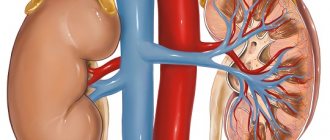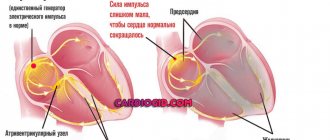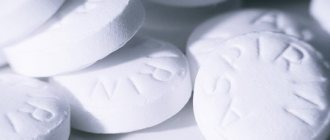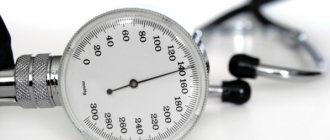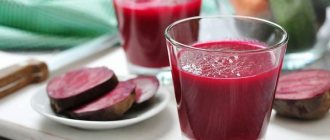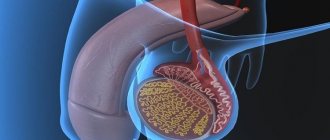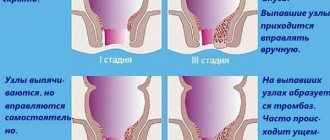What does it mean
What does it mean when the tonometer shows the numbers 160 to 90? The regular appearance of such indicators indicates the transition of hypertension to the second stage. It is important to remember that for representatives of the older age group, blood pressure is 160/90 mmHg. Art. is an acceptable norm.
But only if the condition is not accompanied by the development of a clinical picture typical of hypertension. The reason is the general aging of the entire body and the vascular system in particular. The walls of the blood vessels become less elastic, which leads to an increase in blood pressure (blood pressure).
Important! Women's blood pressure levels are initially lower than men's. Therefore, blood pressure 160/90 is a sure sign of hypertension.
Symptoms
An increase in blood pressure up to 160 to 90 can be recognized by characteristic symptoms. Patients exhibit the following symptoms:
- My ears are ringing and making noise.
- Loss of coordination, possible sweating in space.
- Vision deteriorates, sharpness is lost, and “goosebumps” appear in the eyes.
- Nausea and vomiting.
- The headache is very severe, and there is a pulsation in the temporal and occipital regions.
- Produces a lot of sweat.
- Increased irritability, aggression.
- The skin becomes red, especially on the face and neck.
- Chills.
- Tingling sensation in fingers and toes.
- Palpitations.
As soon as symptoms appear, blood pressure measurements should be taken. If the reading is 160 over 90 and persists for a long time or the pressure increases frequently, then you should immediately consult a doctor. After diagnosis, he will determine the provoking factors and will be able to prescribe the correct treatment.
Normal or pathological?
Blood pressure 160/90 mm Hg. Art. Is it the norm or a deviation? Most often, this level of blood pressure is considered by doctors as a pathology and indicates the development of the second degree of hypertension. The condition in this case is accompanied by characteristic symptoms and requires drug treatment.
Sometimes this blood pressure may be normal. This indicator can occur in men over 40 years of age or people with a large physique and tall stature. At the same time, there are no unpleasant manifestations characteristic of hypertension.
Diagnostics
The examination is carried out under the supervision of a group of specialists. The first is a cardiologist. As necessary (to study the origin of arterial hypertension).
List of activities in correct order:
- Oral questioning of the patient and collection of anamnesis. First of all.
- Measurement of pressure and heart rate.
- 24-hour Holter monitoring. The main indicators are recorded for 24 hours. Considered the gold standard, although little is known about etiology.
- Electrocardiography. Assessment of functional deviations. Variants of arrhythmias are possible, from typical sinus tachycardia to ventricular extrasystoles and others.
- Echocardiography. Visual technique. Aimed at identifying organic pathologies and defects. The classic sign of advanced hypertension is left ventricular hypertrophy.
- Load tests. Carefully.
Advanced diagnostics includes blood tests (general, biochemistry, hormones), urine (clinical, according to Zimnitsky).
Also assessment of the neurological status using routine methods, electroencephalography, MRI of the brain (rarely), scintigraphy of the liver, kidneys, and thyroid gland. It is possible to prescribe FVD and X-ray of pulmonary structures.
Possible reasons
There are a number of factors that provoke a significant increase in blood pressure levels.
Physiological
They are relatively rare. The person does not have any symptoms. Although short-term dizziness or increased heart rate may occur. The reasons may be:
- Puberty. The body of a teenager during the period of growing up - from approximately 12 to 19 years - undergoes powerful hormonal changes, which can provoke a significant increase in blood pressure. Hypertension in this case is secondary in nature and goes away after the root cause is eliminated. Isolated episodes of high blood pressure occur in most young people. Despite the natural causes of pressure surges - changes in hormonal levels - a teenager should be observed by a cardiologist.
- Pregnancy. In rare cases, blood pressure 160/90 is a variant of the physiological norm. But most often, an increase in pressure to such high levels indicates the development of late toxicosis.
- Stressful situation. The reason for the jump is the release of a large amount of hormones into the blood - adrenaline and cortisone. They cause vasoconstriction and stimulate the central nervous system.
- Increased physical activity. Typical for athletes and people whose work involves lifting heavy weights.
- Abuse of drinks containing caffeine. They provoke an increase in the tone of the walls of blood vessels, which causes a sharp jump in pressure. The effect can last two to three hours.
- Drinking large amounts of alcohol. The drink has two opposite effects. Initially, it dilates blood vessels, which causes a decrease in blood pressure. After 10–15 minutes, the vascular lumens, on the contrary, narrow. This causes an increase in blood pressure and an increase in heart rate.
- Smoking. Nicotine also has a very negative effect on the condition of blood vessels, causing not only a persistent increase in blood pressure, but also heart disease and atherosclerosis of the veins of the lower extremities.
- Oral contraception. Drugs in this group can cause persistent hormonal imbalances and, as a result, an increase in blood pressure. The condition is reversible as a woman can correct her condition on her own. Therefore, surges in blood pressure do not always result in the development of hypertension.
Pathological (heart)
The reasons in this case may be:
Diet for arterial hypertension
- Atherosclerosis of large vessels. Persistent increase in blood pressure to 160/90 mm Hg. Art. occurs against the background of complete/partial blockage of the lumen or its stenosis (narrowing). If left untreated, the condition leads to vascular obstruction.
- Heart defects (congenital/acquired). In most cases, this is valve insufficiency, dysfunction of the septum. Therapy is possible only surgically and consists of restoring normal heart function and lowering blood pressure levels.
- Diseases of the heart and pericardium of an inflammatory nature. They cause destruction of cardinal structures or accumulation of fluid and subsequent compression. The patient needs urgent hospitalization. Treatment is with antibiotics, corticosteroids, etc.
- Rheumatism, diseases of autoimmune origin.
- Heart attack or stroke. Pathologies are accompanied by impaired nutrition of myocardial or cerebral tissue (in case of stroke). Increased blood pressure is a symptomatic manifestation that lasts up to six months. Treatment is carried out with antihypertensive drugs.
Pathological (non-cardiac)
An increase in blood pressure to 160/90 can also be provoked by:
- Kidney diseases, in particular, renal failure (acute, chronic, in the stage of decompensation). Treatment should be carried out by a nephrologist.
- Liver failure. The reason for the increase in blood pressure is organic changes in organ tissue. Most often it is hepatitis or cirrhosis. More rarely, the provoking factor is oncopathology.
- Endocrine disorders – hyperthyroidism (overactivity of the thyroid gland), active production of the hormone cortisol by the adrenal cortex.
- Injuries, neurogenic conditions.
- Hormonal imbalances during gynecological diseases.
Correcting hypertension at home
Home help for relief of high blood pressure is differentiated.
First aid
If the pressure reaches 160 over 100 or 110 and continues to rise, an ambulance must be called, especially if a person experiences the following symptoms:
- severe burning pain behind the sternum;
- fear of death;
- profuse sweat;
- dyspnea;
- tachycardia
Otherwise, you may develop a heart attack or stroke with unpredictable consequences. In other cases, the main task is to achieve a decrease in SBP/DBP within the first hour after its rise. Before the doctors arrive:
- half-lay the person on high pillows;
- provide a flow of fresh air;
- calm the patient;
- ask to breathe shallowly, evenly;
- give 20 drops of sedatives - Corvalol;
- if there is a treatment regimen developed by the doctor earlier, follow the instructions;
- on the calves - mustard plaster, on the feet - a heating pad, under the tongue - a Nitroglycerin tablet;
- regular tonometry.
All actions are recorded and transmitted to the doctor.
Drug therapy
Blood pressure of 160 to 100 or higher can only be corrected with medications. It is reduced gradually; an overdose of drugs or an incorrectly selected drug can sharply reduce blood pressure to critical levels. Use:
- diuretics: Hypothiazide, Indapamide, Lasix, Spironolactone, Veroshpiron - remove excess fluid from the body, facilitating the functioning of the heart and blood vessels;
- antispasmodics – Spazgan, Maksigan, Scopolamine, Spanil, Platyfillin – relieve spasm of the arteries;
- hypotensive - Norvasc, Amlodipine, Renitek, Ko-Renitek, Concor - affect the body's enzyme systems, metabolic processes, and nervous system in various ways, normalizing blood pressure.
The doctor chooses the treatment regimen. Spontaneous administration of drugs is prohibited.
Folk recipes
Hypertension of the second degree allows the use of folk recipes as a background:
- Flax seeds contain large quantities of essential omega-3 fatty acids, which rejuvenate blood vessels and increase their elasticity. The body cannot synthesize these substances on its own; they must constantly be supplied to it through food. The recipe for treating hypertension is simple: grind the seeds in a blender and add them to salads, main courses, and sprinkle on sandwiches. By including flax seeds in your diet, you can extend your life by an average of 5 years;
- tincture of red pine cones is used not only to treat hypertension, but also after a stroke, to normalize motor function in case of partial paralysis: the raw materials are collected in June-July, washed, poured into a liter jar, then poured with vodka or alcohol, infused for a couple of weeks in the dark at at room temperature, filter, drink three times a day, half an hour before meals, a teaspoon;
- garlic is a folk remedy for the treatment of high blood pressure, two cloves of garlic are crushed, poured with a glass of boiled water, and left for 12 hours. Drink a glass of garlic water in the morning and evening. The course of treatment is a month;
- Unpeeled pumpkin seeds in a half-liter jar are boiled for two hours, cooled and drunk throughout the day;
- A glass of cucumber juice taken in the morning on an empty stomach helps remove toxins from the body and reduces vascular tone.
All prescriptions must be approved by your doctor.
Symptoms
Symptoms accompanying an increase in blood pressure to 160/90 mmHg. Art., will be the same for both men and women. Conventionally, they can be divided into two groups: basic and indicating the development of conditions requiring immediate medical attention.
Main manifestations:
- Headache. The main area of localization is the parietal and occipital zone. The pain is intense. Headaches in the second stage of hypertension are almost always constant. The intervals between attacks are very short – sometimes no more than a day. As the body gets used to the new blood pressure, the pain gradually disappears, leaving the patient with only a feeling of heaviness in the head. This significantly complicates the diagnosis of pathology, since the tonometer readings stabilize.
- Dizziness (poor orientation in space). A person experiences it during acute periods.
- Dyspnea. It is a consequence of a violation of the gas exchange process.
- Tachycardia (rapid heartbeat).
- Fainting states. They are rare. As a rule, fainting can occur at the stage of the body “getting used to” a new level of blood pressure or with the development of a hypertensive crisis.
- Noise in the ears, flickering of black flies in the field of vision, split images, etc.
- Feeling nauseous. May end with bouts of vomiting.
When cardinal problems (disturbances in the functioning of the myocardium) occur, the patient develops rhythm disturbances, blue discoloration appears in the area of the nasolabial triangle, and the entire surface of the skin becomes significantly paler. When emergency conditions occur, the symptoms not only intensify, but also get worse. The clinical picture develops very quickly.
A person experiences: an unbearable headache, complete disorientation - the patient cannot navigate in space, discomfort in the chest area - the person experiences a pressing pain that disrupts the breathing process, severe arrhythmia, paresis, paralysis, distortion of facial features.
Impaired vision, speech and hearing occur, dysuria - a person cannot empty the bladder, syncope - a short-term fainting, which is accompanied by impaired muscle tone, a malfunction of the myocardium and respiratory system, and the sensation of goosebumps running across the skin.
Important! If such symptoms develop, the patient must call an ambulance, since treatment should be carried out in a hospital setting.
Treatment
If we talk about what to do if a person’s blood pressure rises to 160/90, then it is first necessary to identify the cause of this condition. As a rule, hypertensive patients are well aware of their disease and the provoking factor is well known to them.
In all other cases, you should consult a doctor. The specialist will give all the necessary recommendations. If blood pressure increases very quickly and is accompanied by a significant deterioration in well-being, then the patient urgently needs to call a medical team.
When medication is not required
If the reason for the increase in blood pressure to 160/90 was an external factor - stress, physical overexertion - then no specific measures to stabilize it will be required. In this case, a person needs to create conditions for proper rest and relaxation. It is necessary to ensure a good flow of fresh air in the room by opening the window or the entire window.
Valerian tincture is used if blood pressure has increased due to a stressful situation
To relieve overexcitation from the central nervous system, doctors recommend taking any tincture with a calming effect. For example, valerian or motherwort. If the condition is accompanied by a severe headache, then you can take any painkiller.
Drug treatment
If blood pressure is constantly maintained at 160/90, then the person needs complex treatment. Therapy requires mandatory medication. The following types of medications are used in the process: diuretics, drugs that dilate the lumens of blood vessels, ACE inhibitors, neurotropic drugs, drugs to restore normal myocardial activity.
How can you reduce the pressure from 160 to 90 if you need to do it quickly? In this case, you can use the following medications:
- Captopril. The tablet is designed to dissolve slowly. To do this, place it under the tongue and wait for complete dissolution. As a rule, the patient's well-being improves over the next 15 minutes. Pathological symptoms go away. A contraindication is individual intolerance to the component composition of the medication.
- Nifedipine. It is also used to quickly lower high blood pressure. The tablet is placed under the tongue.
- Propranalol (modern beta blocker). The drug is recommended to be taken in critical situations. Contraindications: heart failure, bronchial asthma.
Classic drug treatment can be supplemented with folk recipes. But they should not cancel their prescribed medications.
Folk recipes
There are many folk recipes that will help reduce and stabilize blood pressure. Before starting treatment, you must consult with your doctor, since the chosen prescription may have its contraindications.
Among the most effective are the following:
- Pour crushed golden mustache (2 tbsp) with strong alcohol (500 ml). Leave in a dark place for 12 hours to infuse. Take 1 dessert spoon of the tincture in the morning immediately after waking up.
- Prepare oatmeal broth. To do this, boil 50 grams of grains in 5 liters of water for 5 minutes after boiling. Let the mixture stand for 4 hours and boil again. Leave for 2 hours and filter. Pour elecampane root (70 grams) with hot broth after crushing it. Bring to a boil and let cool to room temperature. Add 40 grams of honey. Drink a third of a glass three times a day.
- Pour boiling water (250 ml) over blackcurrant berries (2 tbsp). Boil the composition at a minimum boil for 10 minutes. Leave to infuse for 1 hour and filter. Take the resulting drink ¼ of a glass 4 times a day.
- Combine 1 glass of liquid honey with the same volume of fresh carrot and beet juice. Pour in a little lemon juice and stir. Take 1 tbsp. l. mixture once a day after meals, waiting 3 hours.
Treatment is carried out until the desired effect is achieved.
Folk remedies
IT IS IMPORTANT TO KNOW!
STILL STRUGGLE WITH ARTERIAL HYPERTENSION INCORRECTLY? Reduces stress hormone levels and prevents oxygen starvation Read more »
Even when using natural ingredients and traditional medicine recipes, a doctor's consultation is necessary, since all recipes can harm the body with hypertension. Folk remedies are often used because they have almost no side effects and also include natural ingredients.
Among the popular herbs for pathology is motherwort. This plant is found in almost any herbal medicine.
To create a medicine you need:
- Motherwort, hawthorn, rose hips - 2 tbsp.
- Mint, calamus, valerian root - 1 tbsp.
The ingredients are mixed and poured with boiling water. The product is left for 8 hours, so it is advisable to prepare the medicine overnight. In the morning, you need to strain the infusion and drink ½ glass. For maximum effectiveness, you will need to constantly make a new decoction.
Herbs and other traditional medicine have a complex effect on the body:
- Brings the pulse back to normal.
- Normalize blood pressure.
- Calms the nerves.
It is important not only to treat hypertension with medications and other means, but also to change your lifestyle and diet. It is recommended to keep a diary containing daily records of blood pressure measurements. This will allow you to determine when jumps to 160 to 90 occur, and when the indicator returns to normal.
Prognosis and possible complications
The prognosis of hypertension depends on the dynamics of the process, as well as the presence of aggravating factors. The resistant form is difficult to cure. The probability of death in the next decade, according to medical statistics, is 35%. The indicator depends on the severity of damage to target organs.
Aggravating factors include age 45 years and older, alcohol abuse, nicotine addiction, heart disease, endocrine system disease now or in history, predisposition at the genetic level, poor response to drug treatment, advanced hypertension, incorrectly selected therapy, arrhythmias, cardiac deformities .
In the absence of treatment, the development of the following complications is possible:
- stroke;
- myocardial infarction;
- cardiogenic shock;
- heart failure;
- renal/liver failure;
- internal bleeding;
- dementia, ranging from mild cognitive impairment to profound mental retardation.
Almost all complications cause premature death of the patient.
Prevention
The following recommendations from doctors can be considered as preventive measures: adherence to the principles of proper nutrition, giving up alcohol and smoking, maintaining an active lifestyle, daily feasible physical activity, timely treatment of any identified diseases. And it is also important to avoid stressful and any other negative situations.
Regular increase in blood pressure to 160/90 mm Hg. Art. – a good reason to seek qualified medical advice. A person with the second stage of hypertension needs to receive medications.
Only timely diagnosis and appropriate therapy will prevent the development of life-threatening complications and significantly improve the quality of life.
